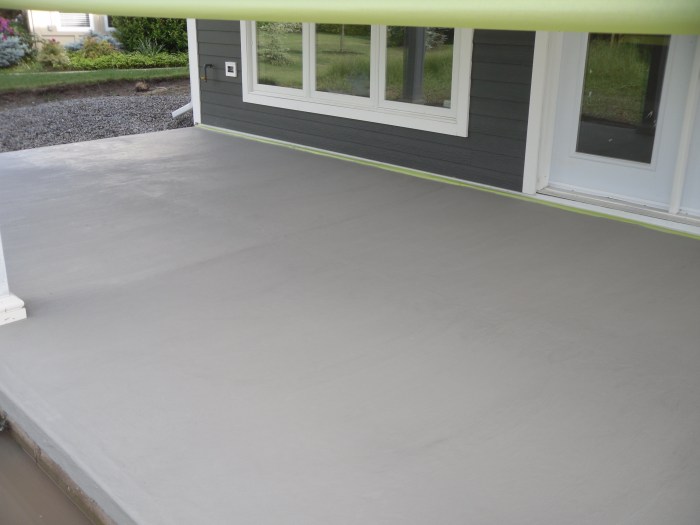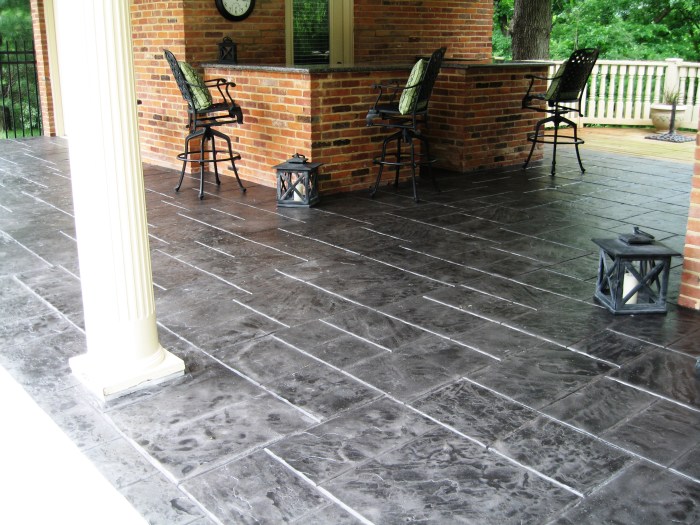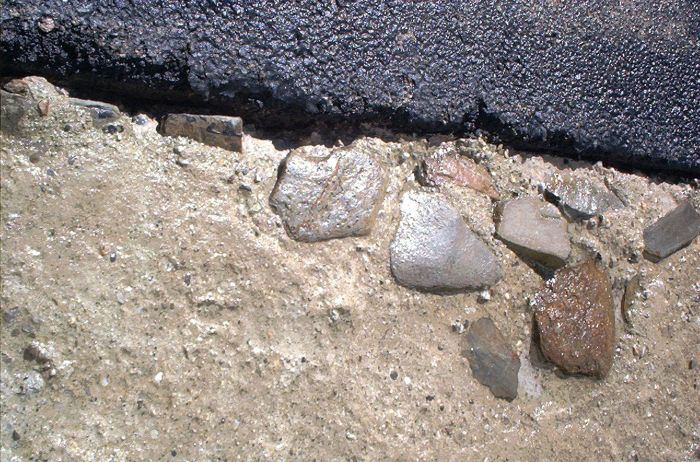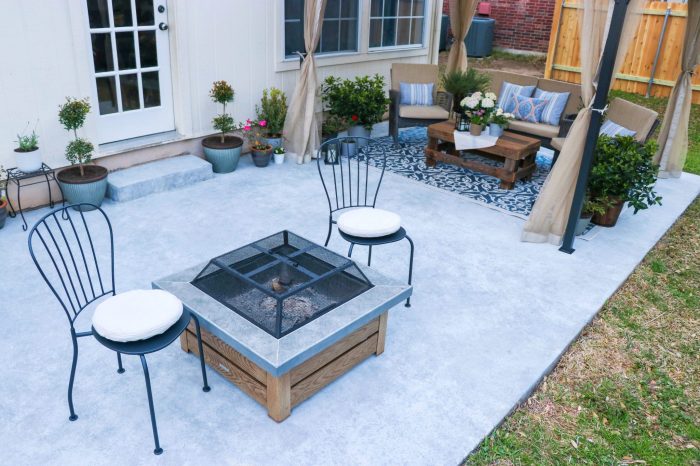How to resurface concrete patio – Embark on a journey of rejuvenation for your concrete patio, transforming it into a vibrant and inviting outdoor haven. This comprehensive guide, “How to Resurface a Concrete Patio,” will equip you with the knowledge and techniques to restore your patio’s pristine beauty and enhance its functionality.
Whether you seek to repair cracks, apply a fresh coating, or completely revamp the surface, this guide will provide you with step-by-step instructions, expert tips, and a wealth of practical advice. Prepare to elevate your outdoor space with a resurfaced concrete patio that exudes both elegance and durability.
Preparation
Preparing your concrete patio for resurfacing is crucial for a successful and durable finish. This involves cleaning, repairing, and leveling the existing surface.
Before starting, gather the necessary tools and materials, including a pressure washer, wire brush, patching compound, leveler, trowel, safety glasses, gloves, and a mask.
Safety Precautions
- Wear appropriate safety gear, including safety glasses, gloves, and a mask, to protect yourself from dust and debris.
- Ensure the area is well-ventilated, as fumes from chemicals used in the resurfacing process can be harmful.
- Keep children and pets away from the work area during the preparation and resurfacing process.
Surface Cleaning
Before applying any resurfacing material, it is crucial to thoroughly clean the concrete surface to ensure proper adhesion and a long-lasting finish. This involves removing dirt, debris, and any old coatings that may hinder the resurfacing process.
Pressure Washing
Pressure washing is an effective method for removing loose dirt, grime, and surface contaminants. Use a pressure washer with a nozzle that generates a pressure of 2,500 to 3,000 psi. Hold the nozzle at a distance of 6 to 12 inches from the surface and move it in a steady, sweeping motion, avoiding excessive pressure that can damage the concrete.
Chemical Cleaning
For more stubborn stains or old coatings, chemical cleaners may be necessary. Choose a cleaner specifically designed for concrete and follow the manufacturer’s instructions carefully. Apply the cleaner to the surface and allow it to dwell for the recommended time.
Use a stiff-bristled brush or broom to scrub the surface, removing any softened contaminants.
Repairing and Patching: How To Resurface Concrete Patio
Once the concrete surface is clean, you need to assess and repair any cracks or damaged areas. These imperfections can compromise the integrity of the patio and affect its appearance.
To identify cracks, look for visible lines or fissures on the surface. For damaged areas, check for chips, holes, or uneven sections.
Patching Holes and Filling Gaps
- Small Holes:Use a concrete patching compound or epoxy to fill small holes. Apply the material with a trowel or putty knife, ensuring it’s level with the surrounding surface.
- Larger Holes:For larger holes, you may need to use a concrete patching mix. This typically involves mixing cement, sand, and aggregate to create a durable patch.
- Filling Gaps:To fill gaps between concrete slabs or along edges, use a concrete caulk or sealant. Apply it with a caulking gun, ensuring it penetrates the gaps thoroughly.
Concrete Patching Materials and Techniques
Choose concrete patching materials based on the size and severity of the damage. Epoxy and concrete patching compounds are suitable for small holes, while concrete patching mix is ideal for larger repairs.
When applying the patching material, follow the manufacturer’s instructions carefully. Ensure the surface is properly prepared and the patch is applied evenly and compacted firmly.
Allow the patched areas to cure completely before proceeding with the next step in the resurfacing process.
Resurfacing Options
Once you’ve cleaned and repaired your concrete patio, it’s time to choose a resurfacing option that suits your needs and budget. Here’s an overview of the most popular options:
The choice of resurfacing option depends on factors such as the condition of the existing concrete, the desired look, and the budget. Consider these options and their pros and cons before making a decision.
Stamped Concrete
Stamped concrete is a popular choice for patios because it can be made to resemble other materials, such as brick, stone, or wood. It’s also durable and easy to maintain.
- Pros:Durable, versatile, can mimic other materials
- Cons:Can be expensive, requires skilled labor to install
Overlays
Overlays are a thin layer of concrete that is applied over the existing concrete. They’re a good option for patios that are in good condition but need a facelift.
- Pros:Less expensive than stamped concrete, can be applied over existing concrete
- Cons:Not as durable as stamped concrete, can crack if not applied properly
Epoxy Coatings
Epoxy coatings are a type of paint that is applied to the concrete. They’re a good option for patios that need a quick and easy update.
- Pros:Inexpensive, easy to apply, can be customized with colors and patterns
- Cons:Not as durable as stamped concrete or overlays, can chip or peel if not applied properly
Application Process
Applying the resurfacing material requires meticulous attention to detail. Proper techniques and careful execution are essential for a durable and aesthetically pleasing finish.
The application process varies depending on the chosen resurfacing material and the desired finish. Here’s a general overview of the common methods:
Troweling
Troweling involves spreading the resurfacing material evenly over the prepared surface using a trowel. This technique is commonly used for cementitious overlays and microtoppings. Proper troweling ensures a smooth, uniform surface with minimal imperfections.
Stamping, How to resurface concrete patio
Stamping creates decorative patterns or textures on the resurfacing material. It is typically used with concrete overlays. After applying the material, stamps with desired patterns are pressed into the surface to create the desired effect. Stamping allows for customization and can enhance the aesthetic appeal of the patio.
Painting
Painting is an option for resurfacing concrete patios with a more decorative finish. It involves applying a specialized paint or coating to the surface. Painting provides a wide range of color and texture options, allowing for personalization and coordination with the surrounding landscape.
Curing and Sealing
Proper curing and sealing are crucial for the longevity and durability of the resurfacing material. Curing involves keeping the surface moist for a specific period to allow the material to fully hydrate and gain strength. Sealing protects the surface from moisture penetration, stains, and wear, extending its lifespan.
Maintenance and Care
Preserving the beauty and longevity of your resurfaced concrete patio requires regular maintenance and care. Proper cleaning, sealing, and inspections will ensure it remains in pristine condition for years to come.
Cleaning
Regular cleaning removes dirt, debris, and stains that can damage the surface. Use a mild detergent and a soft-bristled brush or sponge to gently scrub the patio. Avoid using harsh chemicals or abrasive materials that can scratch or discolor the surface.
Sealing
Applying a sealant every few years helps protect the patio from moisture penetration, stains, and wear. Choose a sealant specifically designed for concrete and follow the manufacturer’s instructions for application. Sealants create a protective barrier that extends the life of the patio and reduces the need for frequent cleaning.
Inspections and Repairs
Regular inspections allow you to identify any cracks, chips, or other damage early on. Prompt repairs prevent further deterioration and ensure the patio remains safe and aesthetically pleasing. If you notice any damage, consult a professional contractor for proper repair techniques.
Closing Summary
As you complete the resurfacing process, take pride in the焕然一新 appearance of your concrete patio. Its restored surface will not only enhance the aesthetics of your outdoor space but also provide a durable and inviting foundation for countless gatherings and memories.
Embrace the joy of entertaining, relaxation, and outdoor living with your newly resurfaced concrete patio.




